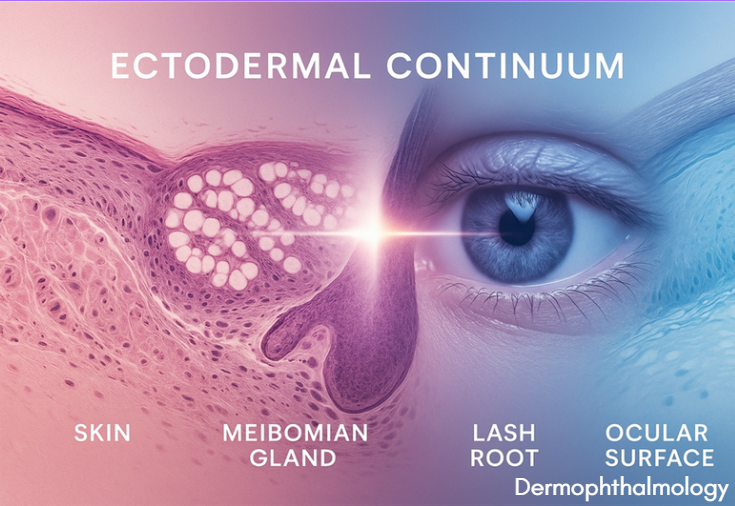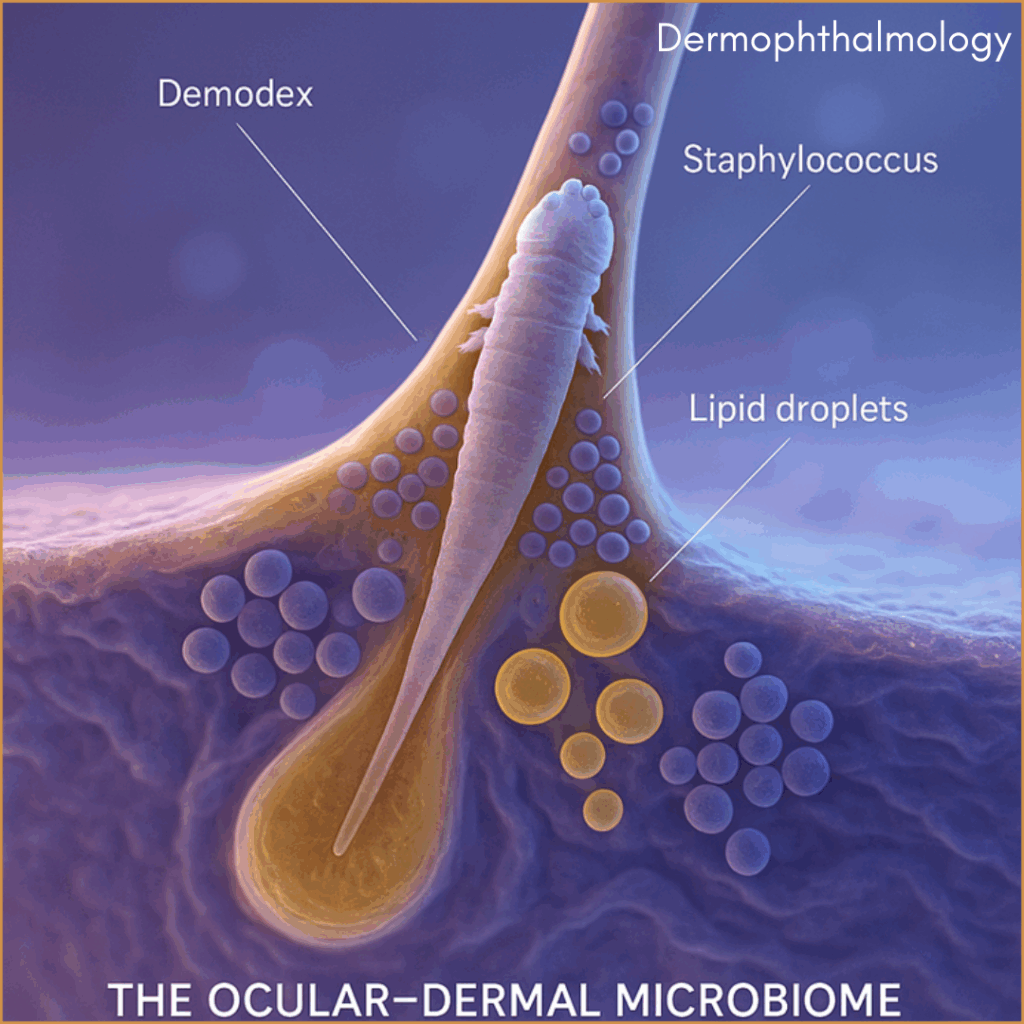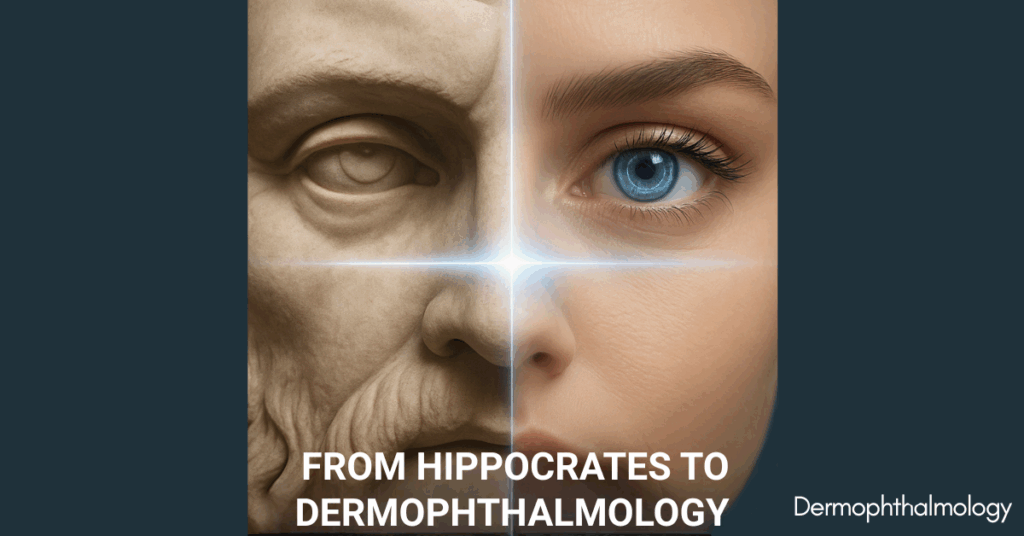Abstract
The concept of eye health has transformed profoundly through the centuries. From Hippocrates and Galen — who saw the eye as a reflection of both body and soul — to Helmholtz and modern visual physiology, Ophthalmology evolved from an interventional art into an autonomous science.
In the 21st century, however, new challenges have emerged: dry eye disease, chronic inflammation, environmental stress, and aesthetic fatigue of the gaze. Traditional definitions of ocular health (AAO, ESCRS, TFOS) focus on visual function, without acknowledging the biological unity of the skin, the tear film, and the lash follicle.
Dermophthalmology, as a new medical discipline, defines eye health as the harmony between skin, tear, and vision. It introduces the Ophthalmoderma — a unified anatomical and functional ecosystem — and establishes new biological axes: the Meibomian–Follicle Axis (MFA), the Tear–Skin Axis (TSA), and the Ophthalmo–Dermal Interface (ODI).
Key Points
- Dermophthalmology represents the natural evolution of Ophthalmology toward a holistic medicine.
- It defines, for the first time, the concept of the Ophthalmoderma as a new target organ.
- It introduces the new definition: Eye health is the harmony between skin, tear, and vision.

Chapter 1. From Hippocrates to Helmholtz
Hippocratic medicine (460 BC) was founded on the principle of balance.
Health was considered the result of harmony among forces, not the mere absence of disease. The eye — the “mirror of the soul” — was viewed as a primary organ through which human vitality and inner life were observed.
Galen (2nd century AD) advanced detailed ocular anatomy, recognizing its connection with the brain and the skin. For the ancient Greeks, vision was a spiritual experience, not only a physical function.
The true turning point came in 1851, when Hermann von Helmholtz introduced the ophthalmoscope, allowing physicians to literally “see inside the eye.” From that moment, Ophthalmology gained its own organ and theoretical foundation.
Chapter 2. The 20th Century – From Physiology to the Microenvironment

Researchers such as Baudouin, Marguerite McDonald, Pflugfelder, and Tsubota ushered Ophthalmology into a new era – the era of the ocular surface.
The publication TFOS DEWS II (2017) was a turning point in global ophthalmic thought: Dry eye disease was recognized as a multifactorial disorder of the tear film and its glands, involving immune, microbial, and environmental components.
At the same time, their landmark studies demonstrated that the ociular surface is not a single organ but a dynamic interface between epithelium, lipids, nerves, and skin. This concept of the microenvironment forms the bridge that Dermophthalmology expands upon, introducing the dual interface – inward toward the tear film and outward toward the lash follicle.
Baudoin C. et al. “A New Approach for Meibomian Gland Dysfunction and Ocular Surface Inflammation.” Prog Retin Eye Res, 2016
Mc Donald M. et al. “A Comprehensive Review of Dry Eye Disease and its Impact on Vision.” Eye Contact Lens, 2014
Pflugfelder S.C & Stern M.E. “Pathophysiology of Dry Eye Disease: New Perspectives and Clinical Implications.” Ocul Surf, 2020
Tsubota K. et al. “Tear Film and Ocular Surface Health.” Ocul SURF, 2017.
Chapter 3. The Missing Link in Modern Understanding
Classical Ophthalmology focuses on visual clarity. Dermatology focuses on the skin. Dermophthalmology recognizes that true ocular health originates at their interface — where glands, follicles, and skin function together as one system: the Ophthalmoderma.


Chapter 4. The New Definition of Eye Health
Eye health is the harmony between skin, tear, and vision.
This definition restores medicine to its Hippocratic roots. It is neither purely ophthalmological nor dermatological — it is holistic. It describes a new paradigm of prevention, where cleanliness, lipid balance, microbial harmony, and aesthetic integrity define the natural health of the gaze.
Chapter 5. From Tear to Skin – The New Biological Axes
Dermophthalmology is founded upon three key biological axes:
- Meibomian–Follicle Axis (MFA)
The functional link between the meibomian gland and the lash follicle,
influencing both lipid layer stability and follicular integrity.
- Tear–Skin Axis (TSA)
The biophysical connection between tear film and skin,
regulating hydration, optical clarity, and inflammatory balance.
- Ophthalmo–Dermal Interface (ODI)
The anatomical zone where ocular and dermal systems converge —
the meeting point of health and beauty.
Peral A. et al., Ocul Surf. 2023 – “The ocular–skin microbiome continuum.”

Chapter 6. Embryological Foundations
The meibomian glands, Zeis/Moll glands, and lash follicles originate from the ectoderm, as does the ocular surface (Niyazov 2018; Cotsarelis 2006). Dermophthalmology does not simply combine two specialties — it reconnects what nature originally created as one.


Chapter 7. The Ocular–Dermal Microbiome
The microbiome of the eyelids and ocular surface forms a shared ecosystem with the skin. Dermophthalmology views blepharitis as dysbiosis, not merely inflammation. Its therapeutic goal is not sterilization but microbial harmony.
Zegans M. & Van Gelder R., Curr Opin Microbiol, 2020.
Chapter 8. Parallels with Foundational Thinkers
Just as Helmholtz founded Ophthalmology, Freud founded Psychoanalysis, and Virchow founded Cellular Pathology, so Dermophthalmology establishes a new framework of medical thought: health as the harmony of interfaces.

Chapter 9. Significance of the Paper

This WOD Position Paper is the first international document to clearly define the concept of eye health across biological, historical, and philosophical dimensions.
- It defines the Ophthalmoderma as a new target organ.
- It introduces the biological axes MFA and TSA.
- It reinterprets the role of lashes and glands in ocular homeostasis.
- It proposes a unified framework for prevention, hygiene, and aesthetics.
- It offers the first modern Hippocratic definition of eye health.
What the ophthalmoscope was to Surgery in the 19th century, Dermophthalmology is to Medicine in the 21st — a new vision of the human gaze.
Authorship
Prepared by the Scientific Team of the World Organization of Dermophthalmology (WOD) under the conceptual leadership of John Tsakalos, with reference to the works of international ophthalmologists and researchers including Marguerite Mc Donald, Christophe Baudoin, Stephen C. Pflugfelder, Kazuo Tsubota, Anibal Peral, Dmitry Niyazov, George Costarelis, Michael Zegans, Russell Van Gelder, whose pioneering research has contributed to the advancement of ocular surface science and to the conceptual foundation of Dermophthalmology.
With acknowledgements to the Hellenic ophthalmological community, whose clinical expertise and educational efforts have supported the dissemination of ocular surface and eyelid hygiene practices.
Dermophthalmology, conceived in Greece, and developed through global scientific collaboration, represents the natural continuation of ophthalmic knowledge and the foundation of a new medical era.
(For educational and scientific purposes – Athens, 2025)
Citation Format
World Organization of Dermophthalmology (WOD).
Evolution of the Concept of Eye Health – From Hippocrates to Dermophthalmology.
WOD Position Paper, Athens, Greece, 2025.
Edited by John Tsakalos.
Scientific Motto
“Where Eye Health meets Skin Science.”
(The intersection of vision, balance, and beauty.)

